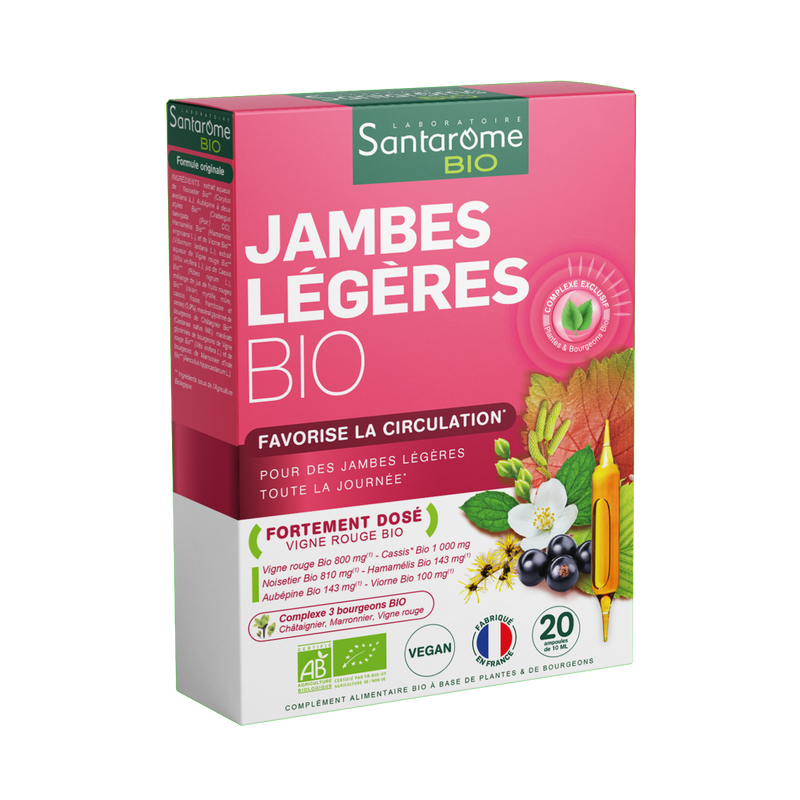The benefits of the chestnut tree
Write the 06/03/2024 by Santarome Bio
The horse chestnut is a majestic tree whose seeds contain precious secrets for the body. As a food supplement to improve blood circulation , chestnut today offers a natural alternative. Discover its benefits and how to use it.

History of the chestnut tree
The Horse Chestnut is native to the Balkans but is said to have been imported to Europe by the ships of the East India Company, hence its name. It is a large tree (around 25 m high) with coppery bark and dark green foliage. We harvest its leaves in summer, and in autumn its bark and its fruits, chestnuts.
Since Antiquity, the Greeks and Romans knew its virtues and used it to relieve various ailments. In the Middle Ages, it was also appreciated for its astringent and anti-inflammatory properties.
It was in the 16th century that the horse chestnut made its entry into Western Europe, where it was quickly recognized for its ornamental beauty. It was then planted in gardens and paths, where it continues to beautify our cities today.
Today, the benefits of horse chestnut are still appreciated. The bark of the horse chestnut tree is used in herbal medicine to relieve joint and muscle pain.
Composition and main active compounds of the Chestnut tree
Beyond its beauty, the horse chestnut is also a tree with key components with multiple uses:
-
Saponins are substances characteristic of the horse chestnut tree. They are present in large quantities in the bark, leaves and chestnuts. Saponins have anti-inflammatory, venotonic and anti-edematous properties.
Escin is a type of saponin specific to horse chestnut. This is what gives it its main therapeutic properties. Escin is a powerful anti-inflammatory that helps reduce pain and swelling. It is also venotonic, which means it tones the veins and improves blood circulation.
Flavonoids are natural antioxidants present in large quantities in the leaves of the horse chestnut tree. They protect cells against damage caused by free radicals. They also have anti-inflammatory and anti-allergic properties.
-
Tannins are astringent substances that have anti-inflammatory and antihemorrhagic properties. They are present in large quantities in the bark of the horse chestnut tree.
Horse chestnut oil is extracted from chestnuts. It is rich in unsaturated fatty acids, vitamins E and F and minerals. It has nourishing, moisturizing and protective properties. It is used for skin and hair care.

Benefits of Chestnut on the body
The fruits, leaves and bark of the horse chestnut tree are full of many benefits. Here are its four main strengths:
Vascular support
Horse chestnut is an excellent venous tonic. It stimulates blood circulation and strengthens the walls of the veins, making it particularly useful for relieving heavy legs, varicose veins and hemorrhoids.
Antioxidant
Horse chestnut is rich in flavonoids, substances that protect cells against damage caused by free radicals. This gives it anti-aging properties and helps fight oxidative stress.
Decongestant effect
Horse chestnut has anti-edematous properties which help reduce swelling and the feeling of heavy legs. It is also effective in relieving bags under the eyes and varicose veins.
Anti-inflammatory
Horse chestnut is a natural anti-inflammatory that can be used to relieve joint and muscle pain, tendonitis and chronic inflammation and thus regain comfort and mobility.
How to consume Horse Chestnut?
Here is how you can consume chestnut to benefit from its benefits:
Dietary supplement
This is the most practical and easiest to use form. They are available in the form of capsules, capsules, ampoules or tablets. The Bio Light Legs food supplement - 20 ampoules of Santarome Bio is formulated with extracts of organic chestnut, organic witch hazel and organic red vine. It is ideal for stimulating and energizing venous circulation.
-
In infusion and decoction
The infusion or decoction is the traditional form of consumption of horse chestnut. To make an infusion, steep 1 teaspoon of crushed chestnuts in 250 ml of boiling water for 10 minutes. For a decoction, boil 50 g of crushed chestnuts in 1 liter of water for 30 minutes. Then filter the preparation before drinking it.
Chestnut extract
Horse chestnut extracts are available in liquid or capsule form and offer a higher concentration of the plant's active ingredients. These extracts can be added to water or fruit juices for easy and convenient consumption, or taken directly as directed by the manufacturer.
Powder
Finally, chestnut is also available in powder form, which can be added to smoothies, yogurts or drinks for daily consumption. Horse chestnut powder is ideal for those who prefer a more versatile and customizable approach to consuming this plant.
















